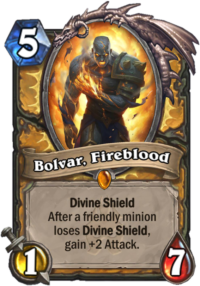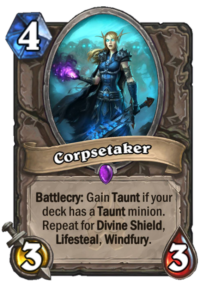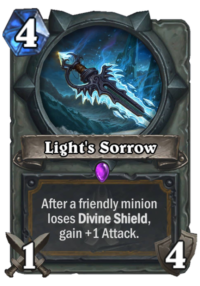We take a look at what could be one of the popular decks coming from Knights of the Frozen Throne, Divine Shield Paladin. This theorycraft guide will help you consider crafts, mulligans, and gameplay!
Knights of the Frozen Throne is just around the corner, and that means all new decks! I am beyond excited for the set because, as a deck builder, it is the influx of new minions and spells that keeps the game fresh. I’ll be discussing/theorycrafting in the coming days, and I thought I’d kick things off with Divine Shield Paladin. Aggro Paladin has always been my forte (took it to legend more than any other deck by a wide margin) and it is something I always like to see pop up. While the list in this article is not strictly aggro, it definitely bends that way. Paladin has relied on murlocs for some time, but I believe the new tools it got with KFT there could change the play style. Yes, you still want to control the board and stack up damage, but the way you go about that may look a little different than what you’re used to.
Divine Shield Aggro Paladin Deck List

This deck, at its core, is an aggressively-slanted tempo build. There are a few ways to go the Divine Shield route, but I think tempo is going to be your best bet. Divine shield minions are the best when they are getting value trades and controlling the board. That then rapidly advances the pace and gives you ways to push as much damage through as you possibly can. If you can get your opponent into a position where all of their minions are going to be invalidated by divine shield trades, then you are likely going to win.
At its core, this deck is very similar to Jambre’s murloc list. You have some cheap minions that build well together, and you use them to go right into your midrange threats like Spikeridged Steed or Sunkeeper Tarim. On top of that, you also have access to the Dread Corsair/Patches the Pirate package as well as a ton of ways to value trade. While the deck does not have the inherent synergy the fish Paladin does, you make up for it with your bubbles. Nothing is better than sticky minions, and this list is absolutely chock full of them. Once you take the board, your aim to is to never let it go.
As you can see, we are all about the curve. You want to kick off the game on turn one with things like Argent Squire and Righteous Protector and then build as quickly as you possibly can. However, also note that there are not too many divine shield synergies here. Rather than trying to build up to some big combo, you want to use the bubbles to make sure your opponent can never cement their spot on the board. Almost every minion in this build, from Sunkeeper Tarim to Corpsetaker to Dread Corsair is a tempo play in its own right. Those, backed up with your strong weapon package, should be enough to match any other deck’s early game.
I also want to specially mention Dark Conviction, which I think really pushes this deck to a new level. The two mana spell may not be Keeper of Uldaman, but you give up the body in order to save two mana. That’s a pretty good trade in a deck that wants to fight for the early board. Versatility is always going to be important in Hearthstone, and this card allows you to push damage, set up trades, and take down large minions. However, it really shines on turn two after a squire or protector. A two mana 3/3 with divine shield is going to create a lot of problems early decks, and believe it will be that interaction that makes this a contender.
Beyond that, everything else looks to fill out the aggressive curve (which tops at six) and push damage. Buffs are extremely solid with the sticky minions, as are most of the one-of tech slots. Leeroy Jenkins is also a great finisher against control. Now that there are no murlocs, the two drop spot is a bit weak. I think Dire Wolf Alpha does a great job of helping you trade and push through damage. It also gets protected by the taunts.
Divine Shield Aggro Paladin Play-Style
As mentioned above, this deck is all about the tempo. Well, tempo and damage. Trading is extremely important in Hearthstone, and nothing gives you trades like divine shields. Even something as simple as using a 2/2 to kill a 2/2 and keep your 2/2 around can change the course of an entire game. This deck is predicated off of that idea, and seeks to give you multiple ways to get out ahead of your opponent. For that reason, I would look at this like the old Midrange Hunter lists more than I would as Midrange Paladin.

For those familiar with the above comparison, you want to spend the first turns of the game getting the board, and the next rapidly pushing for damage. Divine shield and taunt is a great way to put up walls, but it is also a fantastic way to protect your board. Curving your first three minions into a Corpsetaker or curving two minions into Wickerflame Burnbristle is an amazing way to make sure your early damage sticks around. You can then pace the game and set up strong trades while your opponent figures out how to get through your walls. Even if you don’t have such a clean curve, just having minions that don’t die to damage helps when you need to push or set up buffs.
The hardest part of a deck like this is knowing when you need to go face. The transition typically comes around turns four or five when you have a weapon equipped or get full control of the board, but they can happen earlier or later depending on the matchup. When going up against a hyper-aggressive deck you just need to outlast your opponent. Some decks will have more damage, but you have access to cards like Corpsetaker and Spikeridged Steed. Those are your finishers against aggro and should be treated as such. Grind fast decks out of the cards as quickly as possible and then slam a trump card that they cannot answer.
On the other hand, if you’re playing against a slower deck you want to vomit everything you can. Control decks are only going to get stronger with the influx of Death Knights and you need to beat them before they beat you. That proactivity means you can no longer sit back and relxas. Of course, it is always going to be smart to dodge AOE and removal, but do not hold back from doing damage. Your curve ends at six, and once you move past that point you may find yourself in trouble. Once you realize your opponent wants to take their time you need to push, even if that means simply equipping and swinging with a Truesilver Champion on turn four.
(Theoretical) Divine Shield Aggro Paladin Mulligans
You are a tempo deck, and that means you are all about the curve. This build is predicated on generating strong turns, which is extremely hard to do if you fall behind early. Too many decks can snowball out of nowhere. Argent Squire and Righteous Protector are the two cards you want to aggressively find in every single matchup, and keeping Dire Wolf Alpha is also great when you have the coin or need to fill in your curve.
Dark Conviction should be kept when you have a turn one divine shield coming before it (especially against aggro) and both Aldor Peacekeeper and Stonehill Defender are great with the coin or a good curve. The same rule applies to Rallying Blade and Wickerflame Burnbristle. Though almost everything else is too slow, your always want your four drops if you can afford to keep them. Corpsetaker, Truesilver Champion, and Blessing of Kings should always be kept when you have a strong opening before them. Dread Corsair is also a wonderful keep with a coined Rallying Blade.
Divine Shield Aggro Paladin Card Replacements

Before we get to the possible changes you can make to the deck, I wanted to note that, as this is a divine shield list, you may be tempted to play Light's Sorrow. However, the card is just much worse than Truesilver Champion. While sorrow’s damage ceiling is much higher, you lose the healing of champion and need to work much harder to get pressure. Yes, a game or two you might go big, but having a wonky combo is not quite a strong as the reliability of a 4/2.
One advantage of this build is that there are many different ways you can play it. Midrange decks have a lot of tools at their disposal, and those tools can freely be tweaked as you see fit. I love Leeroy Jenkins as a finisher for Freeze and Control, but if you are seeing faster decks you could cut him to quicken your curve. The same rule goes for things like Divine Favor. There is also the possibility of putting in a murloc package as well to give a double whammy. Having both could dilute your draws, but is may also add consistency.
While my version of the deck is fast, you could also make an attempt to up your curve to play a little bit of a slower build. If you were to do this, it would likely include a top-end that revolves around things like Ragnaros, Lightlord and Tirion Fordring. This version would also likely play Howling Commander and operate like a much more traditional midrange deck. If you want to go this route I would cut some of the early cards (though keep the curve intact) and then build up the middle to back end.
Conclusion
Knights is here, and I am excited for the new decks. Divine Shield Paladin seems to have a lot of strong tools that can quickly take over a game. There is no doubt that Uther is going to spend some time in the light (get it?), but it is not clear what version will come to the top. I don’t have an answer to that, but I know there is something good here if you want to play fast games while trying something new. And plus, if you want to play the control option, that’s there for you as well. Thanks for reading and, until next time, may you always curve out!


















/rating_1_half.png)
/rating_2_off.png)
BLOOD KNIGHT
I think when the meta is so unknown, Spellbreaker is a really good filler card for anything midrange-y. I’ll be running it in place of Bolvar. Otherwise, this deck seems solid on paper.
Also, not running Hydrologist is not okay.
This is by no mean an aggro deck.
it’s Mid-range, because it’s too slow and you have several defensive minions (stonehill defender for example).
I actually don’t like it very much. Bolvar seems REEEEEEALY situational…..
I tried but to be honest its not working at all …
Bolvar synergy with divine shield just seems week.
I’m curious about dark conviction. Like half the time you see it you can’t keep it because you are still mulliganing for a 1 drop and it seems like a pretty poor topdeck later.
Having some kind of targeted ‘removal’ for huge enemy minions (especially taunts like Primordial Drake or The Lich King) seems probably worth it to me. But we’ll see.
Hey,
Awesome deck! This looks really fun and I am looking forward to trying it out. I didn’t have enough dust to craft the murloc version, but I already have most of these cards and will be able to craft the others when I open packs. This deck got me so excited that I started playing a non murloc Midrange Paladin on the ladder and it’s working pretty well! Thanks for sharing!